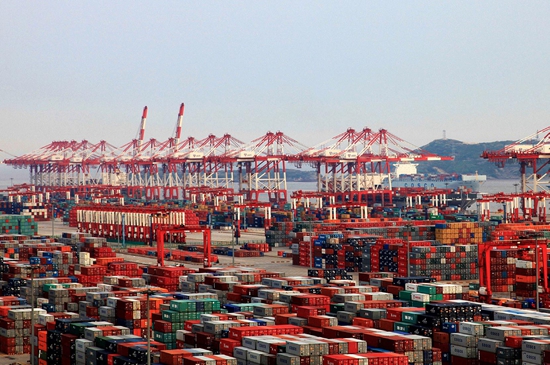
-
Shanghai targets June shift to ‘normal virus mode’
-
Daily new infections fall below 1,000 for the first time since March 24, leading Shanghai officials to announce a shift to ‘normal virus mode’ from June 1
-
No mention of measures to ease reported port congestion, which officials deny and shipping executives blame on COVID-related restrictions on truck drivers
-
More than 100 containerships reported waiting outside Shanghai port for turn to load and unload cargo
Shanghai, home of the world’s largest container port, will shift from a lockdown to “normal virus mode” on June 1 to return China’s commercial hub to normality as the number of new COVID-19 cases fell below 1,000, city authorities said on May 16.
But on Sunday (May 15) and today (May 16), the city’s vice mayors did not mention ways to ease a reported congestion at the port that outsiders blamed on COVID-related restrictions on cargo trucks entering and leaving the terminals, which led most drivers to shun the port, reports said.
China has denied there was any port congestion. Global shipping companies said Shanghai port has been running normally but that the longer wait times for loading and unloading cargo was due to the COVID restrictions relating to trucks.
Chinese media quoted Vice Mayor Zhong Ming as saying in a press conference on Monday the city “will switch to a ‘normal virus control’ mode from June 1 to mid-June or late June,” by which time daily life and production will have returned fully to normal.
Data released on Monday showed new infections dropped 31.5% in the previous 24 hours to 938 cases with symptomatic cases falling 58.4% to 69 while four patients died. The fatality rate stayed at 0.09%. There were 575 deaths out of 620,000 cases.
On Sunday, another Shanghai vice mayor, Chen Tong, announced a gradual reopening of businesses on May 16, but with stricter measures to control the flow of people. He said at shopping malls, department stores, supermarkets and convenience stores will be allowed to reopen “in an orderly manner”.
As of last week, more than 100 containerships were reported as still waiting to dock at Shanghai ports as container and other cargo truck drivers found it difficult to navigate their way to and from the ports without COVID vaccination and the latest test certificates to present at checkpoints.
Shipping Watch quoted Rolf Habben Jansen, chief executive of the German container line Hapag-Lloyd, as saying only half of the cargo coming from the Shanghai region is being loaded onto the vessels. He said it normally takes 48 hours for vessels to unload and load cargoes.
Habben Jansen acknowledged during the company’s first-quarter results announcement last Thursday that many ports are still congested, including Shanghai, and hinterland infrastructures are strained, resulting in longer turnaround times for ships and containers.
“Global supply chains continue to be under significant pressure – not least because of the recent measures taken in China in response to COVID-19 outbreaks,” Habben Jansen said.
Analysts were reported by Shipping Watch as saying the logistics chaos at Shanghai port appeared to be spreading, although the problem that had led liners like Mediterranean Shipping Co and Maersk to omit sailings were not directly linked to the port terminals but to logistics to and from the ports.
Reports from Shanghai said many international manufacturers were already in extreme distress and pessimism at how local authorities have handled the Shanghai outbreak.
Results of a flash survey conducted on May 6-8 on 460 member companies of the German Chamber of Commerce in China showed only a small number of firms had been able to resume production and that their foreign employees were increasingly planning to leave.
The firms cited logistics issue, low availability of staff and uncertainty due to sudden changes in policies as the main reasons hampering the increase of production capacity.
About a third or 28% of foreign staff of the surveyed firms plan to exit China due to the COVID measures, with 10% leaving even before their employment contract lapses.




